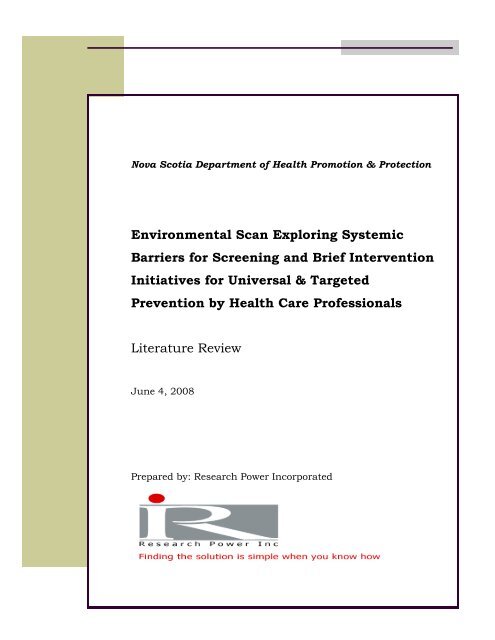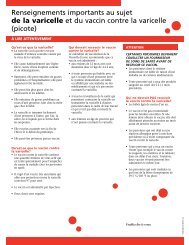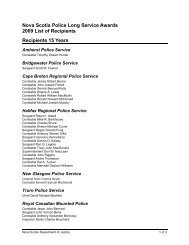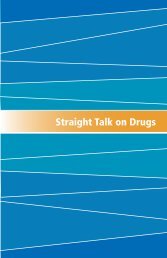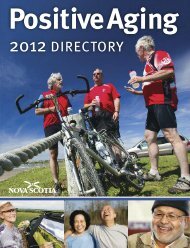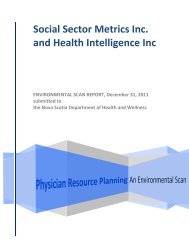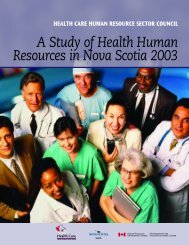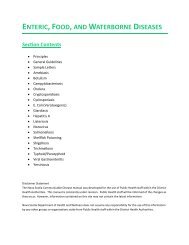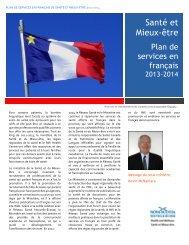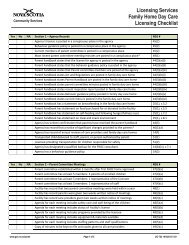Environmental Scan Exploring Systemic Barriers for Screening and ...
Environmental Scan Exploring Systemic Barriers for Screening and ...
Environmental Scan Exploring Systemic Barriers for Screening and ...
Create successful ePaper yourself
Turn your PDF publications into a flip-book with our unique Google optimized e-Paper software.
Nova Scotia Department of Health Promotion & Protection<strong>Environmental</strong> <strong>Scan</strong> <strong>Exploring</strong> <strong>Systemic</strong><strong>Barriers</strong> <strong>for</strong> <strong>Screening</strong> <strong>and</strong> Brief InterventionInitiatives <strong>for</strong> Universal & TargetedPrevention by Health Care ProfessionalsLiterature ReviewJune 4, 2008Prepared by: Research Power Incorporated
Research Power Inc.Table of ContentsLiterature Review ....................................................................................................... 2Introduction .......................................................................................................................... 2 <strong>Screening</strong> & Brief Intervention in Primary Care ............................................................ 2<strong>Barriers</strong> to <strong>Screening</strong> & Brief Interventions by Primary Care Providers ... 3 Inadequate Training & Lack of Knowledge, Skills & Confidence ............................. 3 Lack of Time............................................................................................................................. 5 Negative Patient Reactions & Reception to Questions ................................................. 6 Lack of Detection & Use of Tools........................................................................................ 7 Discom<strong>for</strong>t with Substance Use & Problem Gambling ................................................. 9 Lack of Financial Incentives................................................................................................ 9References............................................................................................................................ 10<strong>Environmental</strong> <strong>Scan</strong> <strong>Exploring</strong> <strong>Systemic</strong> <strong>Barriers</strong> <strong>for</strong> <strong>Screening</strong> <strong>and</strong> Brief Intervention InitiativesNSHPPJune 2008- DRAFT 1i
Research Power Inc.Literature ReviewIntroductionSubstance abuse <strong>and</strong> problem gambling are linked to numerous physical, social<strong>and</strong> emotional health issues such as chronic diseases <strong>and</strong> mental healthillnesses (e.g., cancer, cardiovascular disease, anxiety, depression, etc.), injury,violence, financial problems, family/relationship issues, etc. [1-3]. <strong>Screening</strong><strong>and</strong> brief interventions are increasingly being recognized as proven <strong>and</strong> effectivesecondary prevention strategies <strong>for</strong> substance use (e.g., alcohol, smoking, illicitdrugs, etc.) <strong>and</strong> problem gambling in primary health care settings [4-7].Fleming (2004/2005) [8] describes screening <strong>and</strong> brief interventions (in thecontext of alcohol use) as “screening [<strong>and</strong>] an interview process by whichpractitioners can identify at-risk drinkers…followed by [a] one time or repeatshort counseling sessions…designed to help the patient reduce their drinking <strong>and</strong>minimize related problems” (p.57) [8]. <strong>Screening</strong> & Brief Intervention in Primary CareGiven that primary care professionals (e.g., family physicians, nursepractitioners, family practice nurses, etc.) are the preferred providers bypatients <strong>for</strong> discussing substance issues [9] as well as the effectiveness <strong>and</strong> costbenefits [5] of screening <strong>and</strong> brief interventions, it has been suggested that theybe included as a key role of primary care providers [9, 10]. As described by theMinistry of Health (New Zeal<strong>and</strong>) [11] “there is the opportunity in primary caresettings to provide an integrated package of service provision <strong>and</strong> to intervene atan early stage in the harm continuum, with screening <strong>and</strong> assessment… This willrequire work<strong>for</strong>ce development in primary care settings on screening <strong>and</strong> brief<strong>and</strong> early intervention” (p.20).<strong>Environmental</strong> <strong>Scan</strong> <strong>Exploring</strong> <strong>Systemic</strong> <strong>Barriers</strong> <strong>for</strong> <strong>Screening</strong> <strong>and</strong> Brief Intervention InitiativesNSHPPJune 2008- DRAFT 12
Research Power Inc.It has been suggested that screening <strong>and</strong> brief interventions are effective intheory but less so in practice [12]. The effectiveness of screening briefinterventions have been well documented in the literature, however some havecriticized that this has been done in ideal research conditions <strong>and</strong> does notaccount <strong>for</strong> the barriers faced in ‘real world’ practice [12]. These systemicbarriers have challenged the use of brief intervention in primary health caresettings <strong>and</strong> have prevented the effective engagement of primary care providersworking in ‘real world’ settings. The literature suggests that these barriers areboth practical <strong>and</strong> attitudinal from the providers, the patients <strong>and</strong> the primarycare health system itself [12, 13]. The systemic barriers <strong>for</strong> screening <strong>and</strong> briefintervention by health care providers are the focus of this literature review.<strong>Barriers</strong> to <strong>Screening</strong> & Brief Interventionsby Primary Care ProvidersThe following section presents the literature review related to engagement <strong>and</strong>screening <strong>and</strong> barriers to brief intervention by primary care providers including:inadequate training <strong>and</strong> lack of knowledge, skills, <strong>and</strong> confidence; lack of time;negative patient reactions <strong>and</strong> reception to questions; discom<strong>for</strong>t withsubstance use <strong>and</strong> problem gambling; lack of detection <strong>and</strong> use of tools; <strong>and</strong>,lack of financial incentives. Inadequate Training & Lack of Knowledge, Skills &ConfidenceStudies have identified inadequate training as well as a lack of knowledge, skills<strong>and</strong> confidence around screening, brief intervention <strong>and</strong> discussionssurrounding substance use <strong>and</strong> problem gambling as the most commonbarriers preventing primary care providers from carrying out competent briefinterventions [10, 14-19]. For example, Sullivan, Arroll, Coster, Abbott <strong>and</strong>Adams (2000) [10] found that more than half of physicians surveyed indicatedthat they had low confidence in their ability to raise <strong>and</strong> address issues such as<strong>Environmental</strong> <strong>Scan</strong> <strong>Exploring</strong> <strong>Systemic</strong> <strong>Barriers</strong> <strong>for</strong> <strong>Screening</strong> <strong>and</strong> Brief Intervention InitiativesNSHPPJune 2008- DRAFT 13
Research Power Inc.gambling problems with their patients. Aalto, Pekuri <strong>and</strong> Seppa (2001) [14]revealed that only 18% of surveyed primary care nurses <strong>and</strong> physicians felt theyhad enough knowledge to provide competent brief interventions. Further, only12% had participated in any brief intervention training. Physician confidence inscreening <strong>and</strong> intervening tends to be especially low <strong>for</strong> patients dealing withillicit drug related problems compared with patients with smoking relatedissues [12].Recommended Resources & Strategies to Address Lack of Training,Knowledge, Skills & ConfidenceResearch suggests that primary care providers feel there is a need <strong>for</strong> increased<strong>for</strong>mal training (e.g., university medical education <strong>and</strong> training) <strong>and</strong> continuingmedical education related to substance use <strong>and</strong> gambling problems to facilitatethe engagement <strong>and</strong> use of brief intervention among primary care providers [14,18). With the increased recognition regarding the potential <strong>for</strong> screening <strong>and</strong>brief interventions in primary care settings, several training resources havebeen developed to support primary care providers such as:• Training Physicians in Techniques <strong>for</strong> Alcohol <strong>Screening</strong> & BriefIntervention. Author: The National Institute on Alcohol Abuse <strong>and</strong>Alcoholism’s (NIAAA)• Brief Intervention For Hazardous <strong>and</strong> Harmful Drinking: A Manual <strong>for</strong> Usein Primary Care. Author: Babor, T.F. & Higgins-Biddle, J.C. (World HealthOrganization)• Drink-Less Program (package of materials to assist primary care workersscreen <strong>for</strong> alcohol related problems <strong>and</strong> offer appropriate advice topatients) Author: University of Sydney & the World Health Organization• Alcohol <strong>Screening</strong> <strong>and</strong> Brief Intervention: A Training Program of VeteranService Providers. Australian Government- Department of Veterans’Affairs.<strong>Environmental</strong> <strong>Scan</strong> <strong>Exploring</strong> <strong>Systemic</strong> <strong>Barriers</strong> <strong>for</strong> <strong>Screening</strong> <strong>and</strong> Brief Intervention InitiativesNSHPPJune 2008- DRAFT 14
Research Power Inc.Studies suggests that some of the most effective physician training strategies<strong>for</strong> screening <strong>and</strong> brief intervention include: skills-based role playing (e.g.,interviewing techniques, rehearsals, etc.); per<strong>for</strong>mance feedback (e.g., feedbackregarding practice per<strong>for</strong>mance, patient outcomes, etc.); clinical protocols <strong>and</strong>guidelines (e.g., guidelines in Brief Intervention For Hazardous <strong>and</strong> HarmfulDrinking: A Manual <strong>for</strong> Use in Primary Care); clinic based education; <strong>and</strong>training by credible experts [8, 14].Although training is a recognized facilitator in the use of screening <strong>and</strong> briefintervention, Roache <strong>and</strong> Freeman (2004) [12] caution that a number obstaclesexists in the use of training <strong>and</strong> learning opportunities <strong>for</strong> primary careproviders. <strong>Barriers</strong> which prevent the participation in learning opportunitiesinclude a lack of time, faculty expertise, funding support, training sites,institutional support, <strong>and</strong> competing educational needs <strong>and</strong> priorities amongphysicians <strong>and</strong> nurses [12]. Lack of TimeA lack of time has been identified as another key barrier preventing theimplementation of brief interventions by primary care providers [13, 16, 17, 19].This is due, in part, to patients presenting at primary care settings (e.g., familydoctor offices, walk-in clinics, emergency departments, etc.) with acute issuesrequiring time <strong>and</strong> immediate attention [16, 17, 19]. In a study by Brady et al.(2002) [20], physicians reported that patients were often annoyed when issuessuch as their alcohol consumption were raised as they were most interested inhaving their immediate presenting problems addressed. Its been suggested thata lack of time is also commonly cited as a barrier by primary care providers dueto misconceptions surrounding the length of time <strong>and</strong> ef<strong>for</strong>t required to conductscreening <strong>and</strong> a brief intervention [14, 16].Recommendations <strong>for</strong> Addressing Lack of TimeOvercoming this barrier may include providing supports to physicians throughthe use of nurse practitioners in screening <strong>and</strong> brief interventions. Physicians<strong>Environmental</strong> <strong>Scan</strong> <strong>Exploring</strong> <strong>Systemic</strong> <strong>Barriers</strong> <strong>for</strong> <strong>Screening</strong> <strong>and</strong> Brief Intervention InitiativesNSHPPJune 2008- DRAFT 15
Research Power Inc.who receive training <strong>and</strong> are supported by a nurse are significantly more likelyto provide screening <strong>and</strong> brief interventions that those who receive in<strong>for</strong>mationor guidelines on brief interventions alone [21]. Nurse practitioners have beenfound to be capable of providing effective screening <strong>and</strong> brief interventionswhich help to decrease the time burden on physicians [7]. Its been suggestedthat the use of nurses rather than physicians may also be beneficial to patientswho often feel more com<strong>for</strong>table discussing issues such as substance use <strong>and</strong>problem gambling with a nurse with whom they could relate to rather than withtheir family physician who is often viewed more as an ‘authoritarian’ [17].Further, patient visits with family practice nurses or nurse practitioners aretypically longer than those with physicians, there<strong>for</strong>e allowing additional time tobe spent screening <strong>and</strong> engaging in brief interventions [17]. A literature reviewby Roche <strong>and</strong> Freeman (2004) [12] suggests that nurse screening <strong>and</strong> briefinterventions also cost 10% to 42% less than physician interventions <strong>and</strong> are ofthe same quality of service.It has been recommended that technology be used to overcome the obstacle of alack of time. Moyer <strong>and</strong> Finney (2004) [22] provide examples of variouscomputer programs designed to help physicians screen patients <strong>for</strong> substanceuse <strong>and</strong> gambling problems. These types of programs often take the <strong>for</strong>m ofelectronic surveys which may be completed by patients prior to theirappointment online at home (thereby saving time <strong>for</strong> the physician during inthe screening stage). Results are then made accessible to primary careproviders who may plan <strong>for</strong> a brief intervention should this be needed. Negative Patient Reactions & Reception to QuestionsAnother barrier is uncertainty among providers regarding the reception ofpatients to discussions regarding substance use <strong>and</strong> gambling problems.Given that patients often present in primary care settings <strong>for</strong> more acute issues,providers often are concerned that asking questions around substance use <strong>and</strong>gambling would be inappropriate, intrusive <strong>and</strong> potentially insulting to patients[16, 17]. McCormick et al. (2006) [23] found that patients often disclosein<strong>for</strong>mation regarding their drinking (both in response to questions <strong>and</strong> without<strong>Environmental</strong> <strong>Scan</strong> <strong>Exploring</strong> <strong>Systemic</strong> <strong>Barriers</strong> <strong>for</strong> <strong>Screening</strong> <strong>and</strong> Brief Intervention InitiativesNSHPPJune 2008- DRAFT 16
Research Power Inc.prompting), however primary care providers often do not explore thesedisclosures (e.g., abruptly change the subject, downplay the significant of theirpatients’ drinking, etc.). A review of the literature by Roche & Freeman (2004)[12] revealed that attitudinal barriers by family physicians prevent them fromengaging in screening <strong>and</strong> brief intervention. These barriers includeperceptions that patients with substance use problems are difficult, aggressive,dem<strong>and</strong>ing, manipulative, deceitful, unmotivated <strong>and</strong> unwilling to change.Recommendations to Addressing Perceptions around PatientReactions & Reception to QuestionsContrary to the belief that providers will encounter resistance or negativereactions by patients, Sullivan, McCormick, Lamont, <strong>and</strong> Penfold (2006) [19]found that physicians who used brief intervention <strong>for</strong> problem gambling foundtheir patients to be receptive to questions pertaining to their gambling. Primarycare providers have suggested that their com<strong>for</strong>t around screening <strong>and</strong> askingquestions related to substance use <strong>and</strong> problem gambling is increased <strong>and</strong> seenas more appropriate when its part of patient’s generally lifestyle screening (e.g.,yearly check up, hypertension screening, diabetes clinics, etc.) where thesubstance <strong>and</strong> use of the substance are not the focus of the appointment [17].Further, providers com<strong>for</strong>t in asking questions related to substance use isheightened when the patient exhibits negative health symptoms related tosubstance use as providers perceive that their questions in this case are‘justified’ [13]. Lack of Detection & Use of ToolsFailure to detect substance use <strong>and</strong> gambling problems has been identified asan implementation barrier of brief interventions (Roche & Freeman, 2004). Forexample, through a focus group with family physicians, Sullivan, McCormick,Lamont <strong>and</strong> Penfold (2006) revealed that physicians were unaware <strong>and</strong>surprised by the prevalence of issues such as gambling among their patientpopulations. This lack of detection was due, in part, to the lack of overtphysical symptoms presented by patients with gambling problems. In the case<strong>Environmental</strong> <strong>Scan</strong> <strong>Exploring</strong> <strong>Systemic</strong> <strong>Barriers</strong> <strong>for</strong> <strong>Screening</strong> <strong>and</strong> Brief Intervention InitiativesNSHPPJune 2008- DRAFT 17
Research Power Inc.of other substances such as alcohol, there is confusion <strong>and</strong> lack of awarenessamong many physicians as to what constitutes misuse such that intervention isneeded [26].Recommended Tools <strong>for</strong> DetectionSeveral short, easy to use tools have been developed to overcome this barrier<strong>and</strong> help primary care providers detect <strong>and</strong> screen <strong>for</strong> problematic substanceuse <strong>and</strong> gambling [12]. Commonly used tools which have found to be accurate<strong>and</strong> effective <strong>for</strong> assessing the use <strong>and</strong>/or degree of dependence on varioussubstances [12] are presented in the following table:Table 1: Tools to Assess, Screen & Detect Substance Use ProblemsTarget Substance Tool DescriptionAlcoholSmokingMultiple DrugsProblem GamblingAlcohol Use DisordersIdentification Test(AUDIT)Fast Alcohol <strong>Screening</strong>Test (FAST)Heaviness of SmokingIndex (HSI)Alcohol, Smoking <strong>and</strong>Substance Involvement<strong>Screening</strong> Test (ASSIST)Center <strong>for</strong> Addiction<strong>and</strong> Mental HealthShort Gambling ScreenAccurately predicts patient’sfuture related harm fromalcohol (e.g., illness,hospitalization, social issues,etc.)Abbreviated version of theAUDIT tool, with a highdegree of sensitivity to detectalcohol problemsMeasurement of nicotinedependenceComprehensive measure ofdrug use <strong>for</strong> a variety of drugssuch as alcohol, tobacco,prescription drugs <strong>and</strong> illicitdrugsShort questioning to alertpossible gambling concernsDespite ef<strong>for</strong>ts to create tools that are not only sensitive <strong>and</strong> effective atscreening <strong>and</strong> detecting substance use problems but also short <strong>and</strong> easy to useto facilitate their use by busy primary care practitioners, barriers to their useexist. Roche <strong>and</strong> Freemam (2004) [12] indicate that these tools make use of<strong>Environmental</strong> <strong>Scan</strong> <strong>Exploring</strong> <strong>Systemic</strong> <strong>Barriers</strong> <strong>for</strong> <strong>Screening</strong> <strong>and</strong> Brief Intervention InitiativesNSHPPJune 2008- DRAFT 18
Research Power Inc.‘pen <strong>and</strong> paper’ screening which is not part of st<strong>and</strong>ard clinical protocols orgeneral practitioner culture (i.e., diagnosis via empirical observation <strong>and</strong> verbalquestioning around symptoms). Discom<strong>for</strong>t with Substance Use & Problem GamblingAn obstacle preventing primary care providers from engaging in screening <strong>and</strong>brief interventions is misconceptions <strong>and</strong> discom<strong>for</strong>t around discussingsubstance use <strong>and</strong> problem gambling with patients (16, 23, 24). Manyphysicians find it challenging to raise issues related to gambling, drug <strong>and</strong>alcohol usage with their patients [25]. Research has found that this discom<strong>for</strong>tis due, in part, to physicians fearing interfering or spoiling their relationshipswith patients as well as concerns around loosing patients (16, 17, 23-25). Ithas also been suggested that this discom<strong>for</strong>t is linked to a lack of skills neededto engage in preventative health care, which represents a new way of workingfrom many primary care providers [23]. Lack of Financial IncentivesSome studies have also identified financial barriers (e.g., MSI code <strong>for</strong> briefinterventions), however little is known about potential barriers specific to theCanadian health care system context. Researchers have suggested thatfinancial re-imbursement may encourage providers to include brief interventioninto their clinical practice [15, 27, 28].<strong>Environmental</strong> <strong>Scan</strong> <strong>Exploring</strong> <strong>Systemic</strong> <strong>Barriers</strong> <strong>for</strong> <strong>Screening</strong> <strong>and</strong> Brief Intervention InitiativesNSHPPJune 2008- DRAFT 19
Research Power Inc.References1) Canadian Addictions Survey (CAS) (November 2004). A National Surveyof Canadians’ Use of Alcohol <strong>and</strong> Other Drugs- Highlights <strong>and</strong> RelatedHarms.2) Office of Health Promotion Addictions Services (June 2004). 2003 NovaScotia Gambling Prevalence Study. Nova Scotia Health Promotion &Protection3) Addictions Services Alcohol Task Group (2007). Changing the Culture ofAlcohol Use in Nova Scotia: An Alcohol Strategy to Prevent <strong>and</strong> Reducethe Burden of Alcohol Related Harm in Nova Scotia.4) Humeniuk, R. (2008). The Effectiveness of a Brief Intervention <strong>for</strong> IllicitDrugs Linked to the Alcohol, Smoking, <strong>and</strong> Substance Involvement<strong>Screening</strong> Test (ASSIST) in Primary Health Care Settings. World HealthOrganization.5) Fleming, M.F. (2002). Brief Physician Advice <strong>for</strong> Problem Drinkers: Long-Term Efficacy <strong>and</strong> Benefit Cost Analysis. Alcoholism: Clinical <strong>and</strong>Experimental Research, 26(1); 36-43.6) Fleming, M.F. (1999). Brief Intervention in Primary Care Settings: Aprimary Treatment Method <strong>for</strong> At-Risk, Problem, <strong>and</strong> DependentDrinkers. Alcohol Research <strong>and</strong> Health, 23; 128-137.7) Ockene, J.K., Adams, A., Hurley, T.G., Wheeler, E.V., Hebert, J.R. (1999).Brief physician- <strong>and</strong> nurse practitioner- delivered counselling <strong>for</strong> highrisk drinkers: does it work? Archives of Internal Medicine, 159; 2198-2205.8) Fleming, M.F. (2004/2005). <strong>Screening</strong> <strong>and</strong> Brief Intervention in PrimaryCare Settings. Alcohol Research <strong>and</strong> Health, 28(2); 57-62.9) Lock, C.A. (2004). Alcohol <strong>and</strong> Brief Intervention in Primary Health Care:What do Patients Think? Primary Health Care Research & Development,5; 162-178.<strong>Environmental</strong> <strong>Scan</strong> <strong>Exploring</strong> <strong>Systemic</strong> <strong>Barriers</strong> <strong>for</strong> <strong>Screening</strong> <strong>and</strong> Brief Intervention InitiativesNSHPPJune 2008- DRAFT 110
Research Power Inc.10) Sullivan, S., Arroll, B., Coster, G., Abbott, M., & Adams, P. (2000).Problem Gamblers: Do GPs Want to Intervene? The New Zeal<strong>and</strong> MedicalJournal, 113(1111): 204-20711) Ministry of Health (2005). Preventing <strong>and</strong> Minimising Gambling Harm:Strategic Plan 2004-2010. Willington: Ministry of Health.12) Roche, A.M. & Freeman, T. (2004). Brief Interventions: Good in Theorybut Weak in Practice. Drug <strong>and</strong> Alcohol Review, 23(1); 11-18.13) Hansen, L.J., Olivarius, N.F., Beich, A., Barfod, S. (1999). EncouragingGPs to Undertake <strong>Screening</strong> <strong>and</strong> a Brief Intervention in Order to ReduceProblem Drinking: A R<strong>and</strong>omized Controlled Trial. Family Practice, 16(6);551-557.14) Aalto, M., Pekuri, P. & Seppa, K. (2003). Obstacles to Carrying Out BriefIntervention <strong>for</strong> Heavy Drinkers in Primary Health Care: A Focus GroupStudy. Drug <strong>and</strong> Alcohol Review, 22; 169-173.15) Babor, T.F. & Higgins-Biddle, J.C. (2000). Alcohol <strong>Screening</strong> <strong>and</strong> BriefIntervention: Dissemination strategies <strong>for</strong> medical practice <strong>and</strong> publichealth. Addiction, 95(5); 677-686.16) Babor, T.F., & Higgins-Biddle, J.C. (2001). Brief Intervention ForHazardous <strong>and</strong> Harmful Drinking: A Manual <strong>for</strong> Use in Primary Care.World Health Organization Department of Mental Health <strong>and</strong> Substance.17) Heather, N., Hutchings, D., Dallolio, E., Kaner, E. & McAvoy, B. (2006).Implementing <strong>Screening</strong> <strong>and</strong> Brief Interventions in Primary Health Carein Engl<strong>and</strong>. The Alcohol Education <strong>and</strong> Research Council.18) Rowan, M.S. & Glasgow, C.S. (2000). Identifying Office Resource Needs ofCanadian Physicians to Help Prevent, Assess <strong>and</strong> Treat Patients withSubstance Use <strong>and</strong> Pathological Gambling Disorders. Journal of AddictiveDiseases, 19(2); 43-58.19) Sullivan, S.G., McCormick, R.N., Lamont, M.K., & Penfold, A.A. (2006).Problem gamblers <strong>and</strong> their families can be held by their GP. NewZeal<strong>and</strong> Family Practice, 33(3); 188-19120) Brady, M., Sibthorpe, B., Bailie, R., Ball, S. & Sumnerdodd, P. (2002).The Feasibility <strong>and</strong> Acceptability of Introducing Brief Intervention <strong>for</strong><strong>Environmental</strong> <strong>Scan</strong> <strong>Exploring</strong> <strong>Systemic</strong> <strong>Barriers</strong> <strong>for</strong> <strong>Screening</strong> <strong>and</strong> Brief Intervention InitiativesNSHPPJune 2008- DRAFT 111
Research Power Inc.Alcohol Misuse in an Urban Aboriginal Medical Service. Drug <strong>and</strong> AlcoholReview, 21; 375-380.21) Kaner, E.F.S., Lock, C.A., Heather, N. & Gilvarry, E. (1999). A RCT ofThree Training <strong>and</strong> Support Strategies to Encourage Implementation of<strong>Screening</strong> <strong>and</strong> Brief Alcohol Intervention by General Practitioners. BritishJournal of General Practice, 49(446); 699-703.22) Moyer, A. & Finney, J.W. (2004). Brief Intervention <strong>for</strong> Alcohol Problems:Factors that Facilitate Implementation. Alcohol Research <strong>and</strong> Health, 28.23) McCormick, K.A., Cochran, N.E., Back, A.L., Merrill, J.O., Williams, E.C.& Bradley, K.A. (2006). How primary care providers talk to patientsabout alcohol: A Qualitative Study. Journal of General Internal Medicine,21(9); 996-972.24) Arborelius, E. & Thakker, K.D. (1995). Why is it so difficult <strong>for</strong> generalpractitioners to discuss alcohol with patients? Family Practice, 12(4);419-422.25) Weller, D.P., Litt, J.C., Pols, R.G., Ali, R.L., Southgate, D.O. & Harris,R.D. (1992). Drug <strong>and</strong> Alcohol Related Health Problems in Primary Care-What do GPs Think? Medical Journal of Australia, 156(1); 43-48.26) Rush, B. Ellis, K. Crowe, T. & Powell, L. (1994). How GeneralPractitioners View Alcohol Use: Clearing Up the Confusion. CanadianFamily Physician, 40; 1570-1579.27) Fleming, M. & Manwell, L.B. (1999). Brief Intervention in Primary CareSettings: A Primary Treatment Method <strong>for</strong> At-Risk, Problem, <strong>and</strong>Dependent Drinkers. Alcohol Research & Health.28) Wutzke, S.E., Gomel, M.K. & Donovan, R.J. (1998). Enhancing theDelivery of Brief Interventions <strong>for</strong> Hazardous Alcohol Use in the GeneralPractice Setting: A Role <strong>for</strong> Both General Practitioners <strong>and</strong> MedicalReceptionists. Health Promotion Journal of Australia, 8(2); 105-108.<strong>Environmental</strong> <strong>Scan</strong> <strong>Exploring</strong> <strong>Systemic</strong> <strong>Barriers</strong> <strong>for</strong> <strong>Screening</strong> <strong>and</strong> Brief Intervention InitiativesNSHPPJune 2008- DRAFT 112


